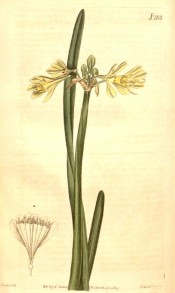Calostemma purpureum R.Br. var. luteum
For a description of the species see Calostemma purpureum R.Br. Very similar to Calostemma purpureum except that it has larger, yellow, or greenish-yellow flowers. [Baker Am.].
Horticultural & Botanical History
Regarded as a true species by some. Botanically described as Calostemma luteum by Sims in 1819 [BM t.2101/1819].
The Flora of Australia, Vol. 45 maintains Calostemma luteum as a separate species, although with reservations. Curtis’s Botanical Magazine retained it as a separate species, but ‘however readily this plant and the preceding [Calostemma purpureum] are distinguished by the colour of the flowers, it is not easy to find specific distinguishing characters.’ [BM t.2101/1819]
‘The present is, we believe, the first season that the flowers of any of the genus have been seen in our gardens. […] Luteum, if really distinct, is certainly very near to purpureum. The chief differences we perceived, consisted in the foliage of luteum being contemporaneous with the inflorescence, while in purpureum it does not appear till long after the decay of the flower; in the anthers of luteum being nearly equal to the naked part of the filaments, in purpureum twice shorter; in the interstamineous sinuses of the coronal web being unindented in luteum, in purpureum bidentate; in the segments of the limb of the corolla in luteum expanding wider and being narrower than in purpureum, where the flower is altogether smaller. Could we have compared fresh plants of the two, perhaps other marks of distinction might have occurred. The three species as yet known are natives of New Holland. The present was observed by the party who performed the late expedition to the south-west of the colony, beyond the Blue Mountains. The two others by Mr. Brown. The drawing was taken from a plant that flowered in the fine collection of Mr. Griffin.’ [BR f.421/1819].
‘In November last the plant of Calostemma luteum, which afforded the figure of the preceding article [f.421], produced another flowering stem at Mr. Griffin’s; the former remaining perfect, though the fruit had opened, and the seeds were germinating at its foot. We observed that the flowers possessed a strong pungent smell, that reminded us of Penny-Royal (Mentha pelugium). [BR f.422/1819].
‘[Calostemma luteum], and all the species, of which five are now on record, is an inhabitant of New Holland. […] One of them at least, C. candidum [Lindl. = C. luteum], is said to be fragrant.’ [BR f.19/1840]. Introduced to Europe with Calostemma purpureum in 1817. [BM t.2101/1819]. FS f.1135/1856.
History at Camden Park
Listed in all published catalogues [B.63/1843]. Seeds of Calostemma lutea were presented to the Sydney Botanic Gardens by Messrs. Macarthur, c.1831 so it was almost certainly grown at Camden Park by this time. [RSBG AB]. This beautiful plant grows in huge numbers in the Riverina district of NSW in damp or even occasionally waterlogged areas. Click here to see a photograph taken in the Riverina in summer 2011.
Notes
Published Apr 06, 2009 - 01:47 PM | Last updated Jun 26, 2012 - 03:18 PM
| Family | Amaryllidaceae |
|---|---|
| Category | |
| Region of origin | Australia |
| Synonyms |
|
| Common Name | Yellow Garland lily |
| Name in the Camden Park Record | Calostemma luteum
|
| Confidence level | high |


